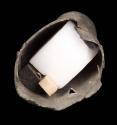Advanced Search
DEACESSIONED October 12, 2023
Right leg of a man
Roman, Eastern Mediterranean
Imperial Period
about A.D. 180–200
Medium/Technique
Bronze
Dimensions
Length: 86 cm (33 7/8 in.)
Credit Line
Gift of Jerome M. Eisenberg and Alan Ravenal
Accession Number68.732
CollectionsEurope, Ancient Greece and Rome
ClassificationsSculpture
Catalogue Raisonné
Greek, Etruscan, & Roman Bronzes (MFA), no. 176A; Sculpture in Stone and Bronze (MFA), p. 121 (additional published references).
DescriptionThe straight, over life-size right leg has thick musculature on the calf and thigh.
Condition: Irregular breaks run along the upper thigh and at the lower shin. The thin layer of porous bronze of this hollow cast leg contains numerous rectangular repair patches and serrated inlays. A casting seam runs down the center of the front of the leg. Two large patch holes are visible on the upper thigh and lower shin on the right side of the leg. Covered in a green and brown patina.
Condition: Irregular breaks run along the upper thigh and at the lower shin. The thin layer of porous bronze of this hollow cast leg contains numerous rectangular repair patches and serrated inlays. A casting seam runs down the center of the front of the leg. Two large patch holes are visible on the upper thigh and lower shin on the right side of the leg. Covered in a green and brown patina.
ProvenanceAbout 1952/1966, probably illicitly excavated at the site of ancient Bubon, near Ibecik, Turkey [see note]. By 1966, Jerome M. Eisenberg, Royal-Athena Galleries, New York; 1968, gift of Jerome M. Eisenberg and Alan Ravenal, Providence, RI to the MFA (Accession Date: November 13, 1968); October 12, 2023, deaccessioned by the MFA for transfer to the New York County District Attorney and return to the Republic of Turkey.
NOTE: On the looting of Bubon between about 1952 and 1966, see George E. Bean, Lycian Turkey: An Archaeological Guide (London, 1978), 164. The leg probably comes from a life-sized bronze statue of an emperor that stood at the imperial sanctuary there.
ADDITIONAL INFORMATION:
In 1966, dealer Jerome Eisenberg showed MFA curator Cornelius Vermeule a suite of bronze fragments, including this leg and a face (former MFA accession no. 2003.786). There is nearly unanimous scholarly consensus, including from Vermeule himself, that the leg was part of a life-sized statue of an emperor from the imperial sanctuary at Bubon. Since the site was not scientifically excavated until 1967, the leg was almost certainly illicitly removed shortly before appearing on the market.
In light of an investigation by the New York District Attorney, in 2023 the Museum reached out to representatives of the Republic of Turkey about the sculptures. The MFA voluntarily transferred the leg and the face to the District Attorney’s office for their return.
NOTE: On the looting of Bubon between about 1952 and 1966, see George E. Bean, Lycian Turkey: An Archaeological Guide (London, 1978), 164. The leg probably comes from a life-sized bronze statue of an emperor that stood at the imperial sanctuary there.
ADDITIONAL INFORMATION:
In 1966, dealer Jerome Eisenberg showed MFA curator Cornelius Vermeule a suite of bronze fragments, including this leg and a face (former MFA accession no. 2003.786). There is nearly unanimous scholarly consensus, including from Vermeule himself, that the leg was part of a life-sized statue of an emperor from the imperial sanctuary at Bubon. Since the site was not scientifically excavated until 1967, the leg was almost certainly illicitly removed shortly before appearing on the market.
In light of an investigation by the New York District Attorney, in 2023 the Museum reached out to representatives of the Republic of Turkey about the sculptures. The MFA voluntarily transferred the leg and the face to the District Attorney’s office for their return.





